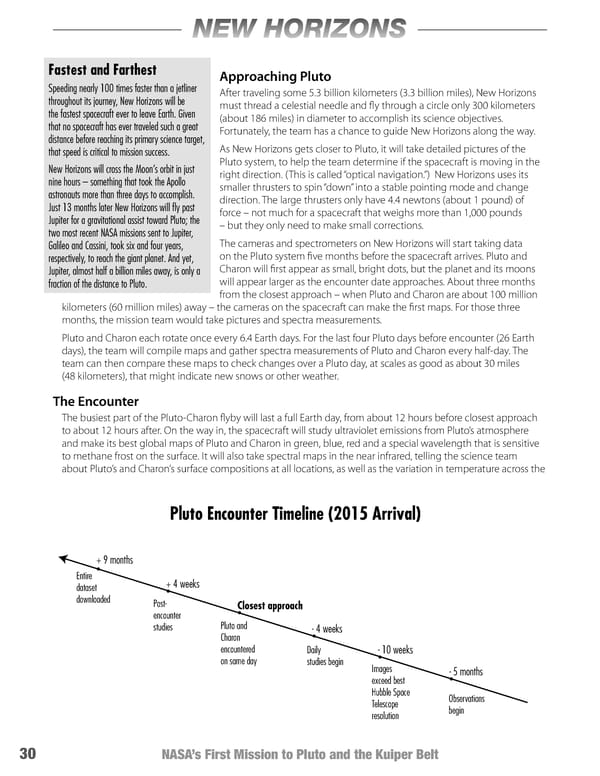NEW HORIZONS Fastest and Farthest Approaching Pluto Speeding nearly 100 times faster than a jetliner After traveling some 5.3 billion kilometers (3.3 billion miles), New Horizons throughout its journey, New Horizons will be must thread a celestial needle and fly through a circle only 300 kilometers the fastest spacecraft ever to leave Earth. Given (about 186 miles) in diameter to accomplish its science objectives. that no spacecraft has ever traveled such a great Fortunately, the team has a chance to guide New Horizons along the way. distance before reaching its primary science target, that speed is critical to mission success. As New Horizons gets closer to Pluto, it will take detailed pictures of the New Horizons will cross the Moon’s orbit in just Pluto system, to help the team determine if the spacecraft is moving in the nine hours – something that took the Apollo right direction. (This is called “optical navigation.”) New Horizons uses its astronauts more than three days to accomplish. smaller thrusters to spin “down” into a stable pointing mode and change Just 13 months later New Horizons will fly past direction. The large thrusters only have 4.4 newtons (about 1 pound) of Jupiter for a gravitational assist toward Pluto; the force – not much for a spacecraft that weighs more than 1,000 pounds two most recent NASA missions sent to Jupiter, – but they only need to make small corrections. Galileo and Cassini, took six and four years, The cameras and spectrometers on New Horizons will start taking data respectively, to reach the giant planet. And yet, on the Pluto system five months before the spacecraft arrives. Pluto and Jupiter, almost half a billion miles away, is only a Charon will first appear as small, bright dots, but the planet and its moons fraction of the distance to Pluto. will appear larger as the encounter date approaches. About three months from the closest approach – when Pluto and Charon are about 100 million kilometers (60 million miles) away – the cameras on the spacecraft can make the first maps. For those three months, the mission team would take pictures and spectra measurements. Pluto and Charon each rotate once every 6.4 Earth days. For the last four Pluto days before encounter (26 Earth days), the team will compile maps and gather spectra measurements of Pluto and Charon every half-day. The team can then compare these maps to check changes over a Pluto day, at scales as good as about 30 miles (48 kilometers), that might indicate new snows or other weather. The Encounter The busiest part of the Pluto-Charon flyby will last a full Earth day, from about 12 hours before closest approach to about 12 hours after. On the way in, the spacecraft will study ultraviolet emissions from Pluto’s atmosphere and make its best global maps of Pluto and Charon in green, blue, red and a special wavelength that is sensitive to methane frost on the surface. It will also take spectral maps in the near infrared, telling the science team about Pluto’s and Charon’s surface compositions at all locations, as well as the variation in temperature across the ��������������������������������������� ���������� ������� ��������� �������� ���������� ����� ���������������� ���������� ������� ���������� ��������� ������� ������������ ������ ���������� ����������� ������������� ������ ����������� ���������� ������������ ������������ ���������� ����� ���������� 30 NASA’s First Mission to Pluto and the Kuiper Belt
 New Horizons Page 39 Page 41
New Horizons Page 39 Page 41